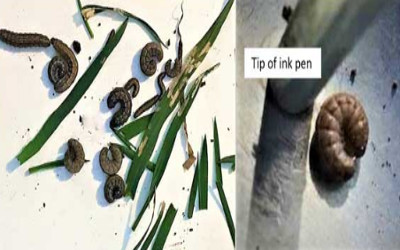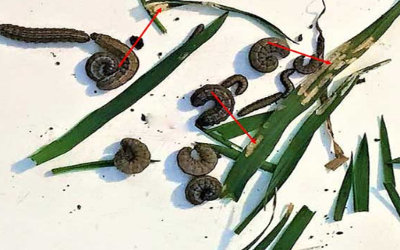By Jeff Whitworth
Army cutworms return to Kansas every year in the fall. Generally, the weather most conducive to army cutworm survival is a dry summer followed by a wet fall. Currently, even though it is still early, significant populations of army cutworm larvae have been reported (Figure 1).

Figure 1. Various sizes of army cutworm larvae collected on March 4, 2020 (left photo). Close-up of cutworm larvae (right photo). Photos by Cayden Wyckoff, K-State Research and Extension.
The two crops most affected are alfalfa and wheat, but canola can also be significantly affected. Alfalfa and wheat are vulnerable because these crops have green, succulent plants during the fall when the moths are ovipositing. However, late-planted wheat fields may escape infestation if plants hadn't germinated when the moths were flying around seeking oviposition sites. Each female can produce 1000-2000 eggs, which hatch in the fall. The small larvae then start feeding on any nearby leaf tissue, and will do so all winter anytime the temperature is over 45 degrees F.
The easiest way to detect an army cutworm infestation early is to take notice of any feeding by animals (birds, skunks, possums, etc.) in wheat or alfalfa fields. Next, go out to that area and dig around the base of the plants looking for the dusky, soil-colored, usually curled up, small cutworms that have faint lateral stripes. These larvae feed on the above-ground portion of plants (Figure 2), and consume more and more plant tissue as they grow.

Figure 2. Army cutworm feeding damage. Red arrows point to the distinctive "windowpaning" feature. Photo by Cayden Wyckoff, K-State Research and Extension.
This feeding will probably continue for another month or two, depending upon the weather. The larvae will then pupate, emerge as adult moths (often called "Miller moths"), then migrate back to the Rocky Mountains for over-summering until heading back to the Plains next fall to start the cycle all over again.
Treatment recommendations
Under good growing conditions treatments should not be necessary unless there are 4-5 larvae/sq ft in wheat-- even more if the wheat is growing well and is well tillered. In seedling alfalfa, probably 1-2 larvae/sq ft may justify treatment but it will take probably at least 4-5 larvae/sq ft in established fields.
Source : ksu.edu